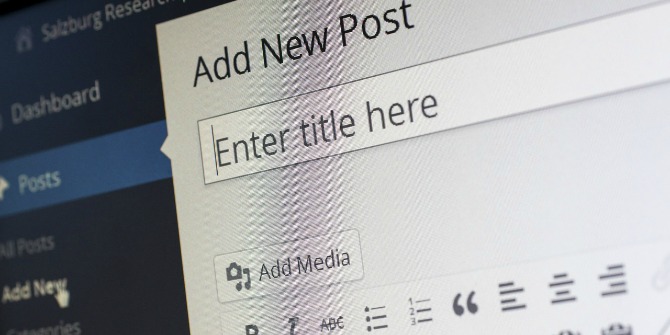The popularity of social media sites and the ease at which its data is available means these platforms are increasingly becoming primary sources for social research. Wasim Ahmed presents a quick look at some of the tools available to social scientists for analysing social media data and also reflects on the limitations of the platforms and the methods used for this type of research.
I have a social media research blog where I find and write about tools that can be used to capture and analyse data from social media platforms. My PhD looks at Twitter data for health, such as the Ebola outbreak in West Africa. I am increasingly asked why I am looking at Twitter, and what tools and methods there are of capturing and analysing data from other platforms such as Facebook, or even less traditional platforms such as Amazon book reviews. Brainstorming a couple of responses to this question by talking to members of the New Social Media New Social Science network, there are at least six reasons:
- Twitter is a popular platform in terms of the media attention it receives and it therefore attracts more research due to its cultural status
- Twitter makes it easier to find and follow conversations (i.e., by both its search feature and by tweets appearing in Google search results)
- Twitter has hashtag norms which make it easier gathering, sorting, and expanding searches when collecting data
- Twitter data is easy to retrieve as major incidents, news stories and events on Twitter are tend to be centred around a hashtag
- The Twitter API is more open and accessible compared to other social media platforms, which makes Twitter more favourable to developers creating tools to access data. This consequently increases the availability of tools to researchers.
- Many researchers themselves are using Twitter and because of their favourable personal experiences, they feel more comfortable with researching a familiar platform.
It is probable that a combination of response 1 to 6 have led to more research on Twitter. However, this raises another distinct but closely related question: when research is focused so heavily on Twitter, what (if any) are the implications of this on our methods?
 Image credit: NodeXL Twitter Search by Marc Smith (Flickr CC BY)
Image credit: NodeXL Twitter Search by Marc Smith (Flickr CC BY)
As for the methods that are currently used in analysing Twitter data i.e., sentiment analysis, time series analysis (examining peaks in tweets), network analysis etc., can these be applied to other platforms or are different tools, methods and techniques required? In addition to qualitative methods such as content analysis, I have used the following four methods in analysing Twitter data for the purposes of my PhD, below I consider whether these would work for other social media platforms:
- Sentiment analysis works well with Twitter data, as tweets are consistent in length (i.e., <= 140) would sentiment analysis work well with, for example Facebook data where posts may be longer?
- Time series analysis is normally used when examining tweets overtime to see when a peak of tweets may occur, would examining time stamps in Facebook posts, or Instagram posts, for example, produce the same results? Or is this only a viable method because of the real-time nature of Twitter data?
- Network analysis is used to visualize the connections between people and to better understand the structure of the conversation. Would this work as well on other platforms whereby users may not be connected to each other i.e., public Facebook pages?
- Machine learning methods may work well with Twitter data due to the length of tweets (i.e., <= 140) but would these work for longer posts and for platforms that are not text based i.e., Instagram?
It may well be that at least some of these methods can be applied to other platforms, however they may not be the best methods, and may require the formulation of new methods, techniques, and tools.
So, what are some of the tools available to social scientists for social media data? In the table below I provide an overview of some the tools I have been using (which require no programming knowledge and can be used by social scientists):
| Tool | OS | Download from | Platforms* |
|---|---|---|---|
| Mozdeh | Windows (Desktop advisable) | http://mozdeh.wlv.ac.uk/installation.html | |
| Webometric Analyst | Windows | http://lexiurl.wlv.ac.uk/ | Twitter (with image extraction capabilities) YouTube Flickr Mendeley Other web resources |
| NodeXL | Windows | http://nodexl.codeplex.com/ | Twitter YouTube Flicker |
| Netlytic | Web based | https://netlytic.org/ | Twitter YouTube |
| Twitter Arching Google Spreadsheet (TAGS) | Web based | https://tags.hawksey.info/ | |
| Chorus | Windows (Desktop advisable) | http://chorusanalytics.co.uk/chorus/request_download.php | |
| DiscoverText (free 30 day trial)** | Web based | http://discovertext.com/ | Twitter Blogs Forums Online news platforms |
| COSMOS Project | Windows MAC OS X | http://www.cosmosproject.net/ | |
| Visibrain Focus | Web based | http://www.visibrain.com/en/ |
*It is advisable to check whether a tool can support other platforms as it may be possible to import data obtained from elsewhere.
**I won a historical data prize from DiscoverText with up to 3 months of gratis access and I also received 3 days worth of Firehose data via Sifter, and this has allowed me to conduct research that would otherwise have not been possible such as comparing Twitter’s Search API to the Firehose API. DiscoverText is used widely in academic research with over 40 scholarly mentions and contains features such as advanced data filtration and machine learning capabilities.
I would also like to mention:
- Deen Freelon’s great curated list of social media tools here at: http://bit.ly/10NjJYK
- The digital methods initiative (DMI tools) here at: https://wiki.digitalmethods.net/Dmi/ToolDatabase
- My research blog (Wasim Ahmed, a blog about my research) here at: https://wasimahmed1.wordpress.com/
By searching for relevant software (as documented in the table), I have noticed that there are very few tools that can be used to obtain data from other social media platforms such as, Pinterest, Goolge+, Tumblr, Instagram, Flickr, Vine, LinkedIn, and Amazon among others. Regarding this, I would like to see more software for those in the social sciences to obtain data for a range of platforms and including a range of data i.e., web links, images, and video. At the Masters and PhD level there should be more emphasis on training for social science students in effectively using existing software that can be used to capture data analyse data from social media platforms.
Parts of this blog post appeared first on Wasim’s research blog.
Note: This article gives the views of the author, and not the position of the Impact of Social Science blog, nor of the London School of Economics. Please review our Comments Policy if you have any concerns on posting a comment below.








Thank you for this piece. The issues surrounding the use of social media posts for research purposes are many. I know that certain ethical review boards of post-secondary institutions are against using publicly available twitter content. I am wondering if you can comment or create a post that addresses the research ethics around using such data, when the subjects are unaware of the use of such data?
Here’s an example of social media being used by academics with impact on individuals. The academics used Jon Ronson’s public twitter feed to create a spambot. The actual Jon Ronson did not like what was happening with the “robot version of himself” created by academics. If this type of work went through an ethical review, I’d be very surprised.
Thanks for this, a great resource for those looking to get into Twitter research for sure! I notice you say:
“In the table below I provide an overview of some the tools I have been using (which require no programming knowledge and can be used by social scientists)”
I’ve always found it interesting to think about social science’s relationship to programming and their resistance to learning programming languages – certainly we started developing Chorus on the basis that although social scientists clearly have an interest in social media as data, there is still a need to flatten out the steep learning curve involved in coercing a computer into getting access to and making analytic sense of that data… but now I’m starting to wonder when it will be that social scientists will just NEED to get good at programming in order to do their work? Certainly the more research I do with social media, the more I’m finding it useful to know my way around a programming language or two, even with all these tools at my disposal (although of course, tools such as those in your list are still probably the best place to start, if you’ll forgive the self-promotion!). Maybe there will always be something missing from ‘digital sociology’ until its practitioners themselves are willing to embrace the digital world in it’s own languages???
NB: I say all this as a sociologist-with-a-few-basic-coding-skills, more a ‘provocative’ devil’s advocate kind of thing than an outright critique 😉 – what do other people think?
Thanks for the great round-up Wasim – I keep coming back to this post as a reference point.
Just wondering whether you’ve had a look at the social media tools in NVivo? I might be a little biased (since I’m an online community manager at QSR) but I think NVivo provides some really useful “non-programming” approaches to analyzing social media.
For example, you can capture a Twitter feed (using the NCapture plugin) and then bring it into NVivo as a dataset (spreadsheet) that you can filter based on attributes like username or no. of followers – you can also auto-code the dataset based on these attributes. In NVivo 11 Plus for Windows you can quickly analyze sentiment in the Twitter dataset and also create a sociogram if you’re interested in social network analysis.
Just thought you might find this useful – thanks again for this great compilation 🙂
Thank your for your post. A piece containing very resourceful information.
nice post
Just wanted to point readers to my about me page on my research blog which has a collection of presentations based on some of the tools I highlighted above. You can access this here: https://wasimahmed.org/about/